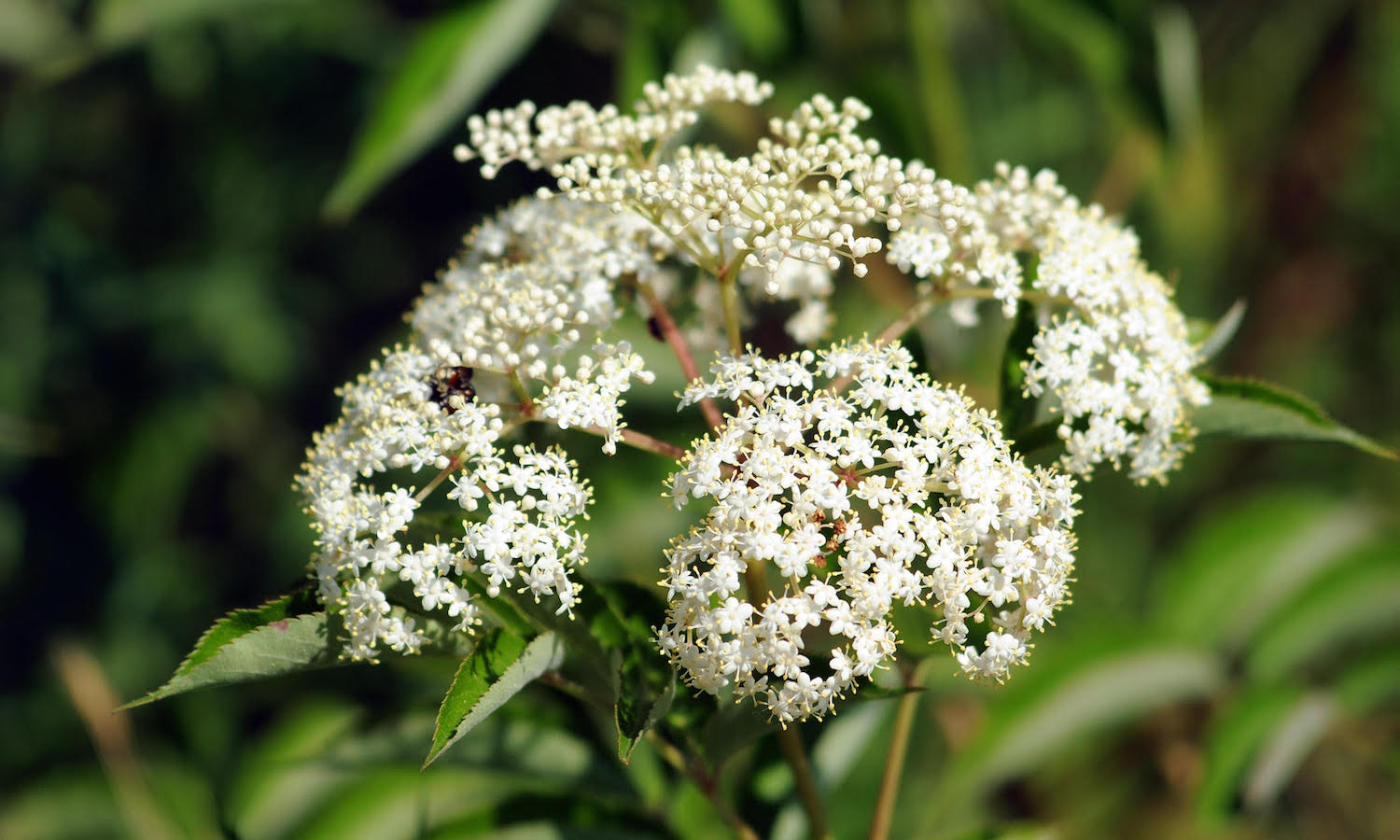Wearing a teal button-down shirt, farmer Terry Durham speaks to a dozen potential elderberry farmers amid an open field. On a brisk spring day in March his annual mentoring workshop will address what they need to know about planting and cultivating the crop while using sustainable growing practices. Participants will also take home a flat of starter plants.
Elderberries provide nearly 40 times more Vitamin C per 100 grams than blueberries do. They have 10 times more Vitamin A when compared to blueberries and nearly six times as much iron. Elderberries are higher in fiber (7 grams) than blueberries are (2.4 grams) too. In addition, this fruit provides calcium, magnesium, zinc and phosphorus. It’s no wonder that some evidence has indicated elderberry may help reduce the flu’s severity and duration.
Durham began a small ‘elderberry revolution’ in tiny Hartsburg, Missouri during the summer of 2011. That’s when he founded River Hills Harvest (RHH). “I started the group to establish an [organization] of elderberry farmers able to provide a consistent commodity [and] a steady product for wholesale and retail sales,” Durham says.
“The advantage for participating farmers is in the aggregation of their product for a larger market, the camaraderie of working with other elderberry growers; and the negotiating power of a larger group.”
RHH grower, Earnie Bohner, agrees. His Persimmon Hill Berry Farm operates in Southwest Missouri. “We have done other [crops] that are perhaps not easily marketed,” he says. “It’s like shiitake mushrooms used to be.” Today Durham educates growers from Maine to New Mexico during hands-on workshops held in March and June.
HOW MUCH DO FARMERS MAKE?
According to Durham, RHH organic farmers in Missouri average 1,800 kilograms (4,000 pounds) of berries per acre (not all RHH farmers are organic). “We pay farmers US$2 per pound when they harvest, have properly processed and frozen [berries] for us,” he says, “so farmers make 25 – 30 percent of the cost of our elderberry juice. In a good year, I have organic growers around the Kansas City area that make up to US$15,000 per acre. [Growers] can purchase their juice back from us in bottles too, at below cost, and then sell it to local markets.”
Although eating raw elderberries is not recommended this small, blue-purple fruit features high concentrations of Vitamin-C, Vitamin-A, and B-complex vitamins. Calcium, potassium, manganese, iron, and phosphorous are additional nutrients. Long revered for potential health benefits, Hippocrates called elderberries “Nature’s medicine chest for the common people.”
“My background is in public health,” Bohner says, “and the National Institutes of Health are doing research regarding anti-inflammatory properties of elderberries [too].”
Durham became acquainted with elderberries during childhood, when his grandmother made elderberry jam and his family sometimes sold elderberries at farmers markets. He planted his first elderberry crop in 1997 after decades of organic farming. Simultaneously, the University of Missouri Center for Agroforestry wanted to start an elderberry improvement project with new cultivars. In 2005 Durham planted propagation from the University’s research project. His first one-acre field followed a year later.
Harvested in the Central United States, RHH berries meet exacting FDA growing and processing standards. Growers harvest up to 10-inch berry clusters at peak ripeness to retain the highest level of natural nutrients for use in elderberry products.
“We’re growing a native plant so we don’t need to do any spraying,” Durham says. “We grow native grasses and legumes between rows and [other] rows of plum and nut trees. Elderberry loves compost and sends its roots out for a long way.
“We cut bushes to the ground each winter and they come up in the spring. They start to bloom in June. By August they are ripe and it’s our main harvest time. There’s useable fruit by the second year after you’ve planted and you get a full harvest by the third year. One stem coming up averages about a quarter pound of fruit with 6-8 stems planted every two feet.”
Collected in 11.3398-kilogram (25-pound) pails and labeled according to the farms they come from, RHH berries are picked, prepped and frozen in a single day. “We worked for years on our process to separate stems from berries,” Durham says. “We had to develop a machine that takes the berries off.” He and his brother designed stainless Steel Sanitizing Baskets and other equipment which Venture Manufacturing now crafts in Lee’s Summit, Mo.
After stemming berries are sanitized in the first of several sinks. Ripe fruit drops to the bottom as debris and unripe fruit float to the top. Once they’re fully rinsed the berries drain on racks.
Durham then makes elderberry products with 100-percent fresh juice, from health cordial syrup to lemonade. “I had seen elderberry concentrate from Europe at a good price and we started making juice [ourselves],” Durham says. “We’re the only producers of pure elderberry juice in the world, as far as we know.”
He gently heats elderberries before bottling, achieving a temperature that falls just below the point where nutrients would degrade. Adding citric acid helps to maintain the appropriate PH. All products carry the River Hills Harvest Pure Premium ElderBerry name.
“Midwest Elderberry Cooperative makes our elderberry jam and jelly,” Durham says. “Jelly starts with Grandma’s recipe and some sugar taken out. There’s some sugar in our syrup and the cordial is sweetened with honey, cinnamon and clove.” The non-GMO, and gluten and alcohol-free elderberry products are available in more than 500 retail stores or online.
“Any agri-preneur has to have a myriad of skills to be a farmer and it may not overlap with marketing skills,” Bohner says. “So sharing ‘risk’ is really helpful. With a group like RHH you have elderberries on a larger scale. You also have an individual with promotional skills and knowledge to process elderberries and make the products.”















